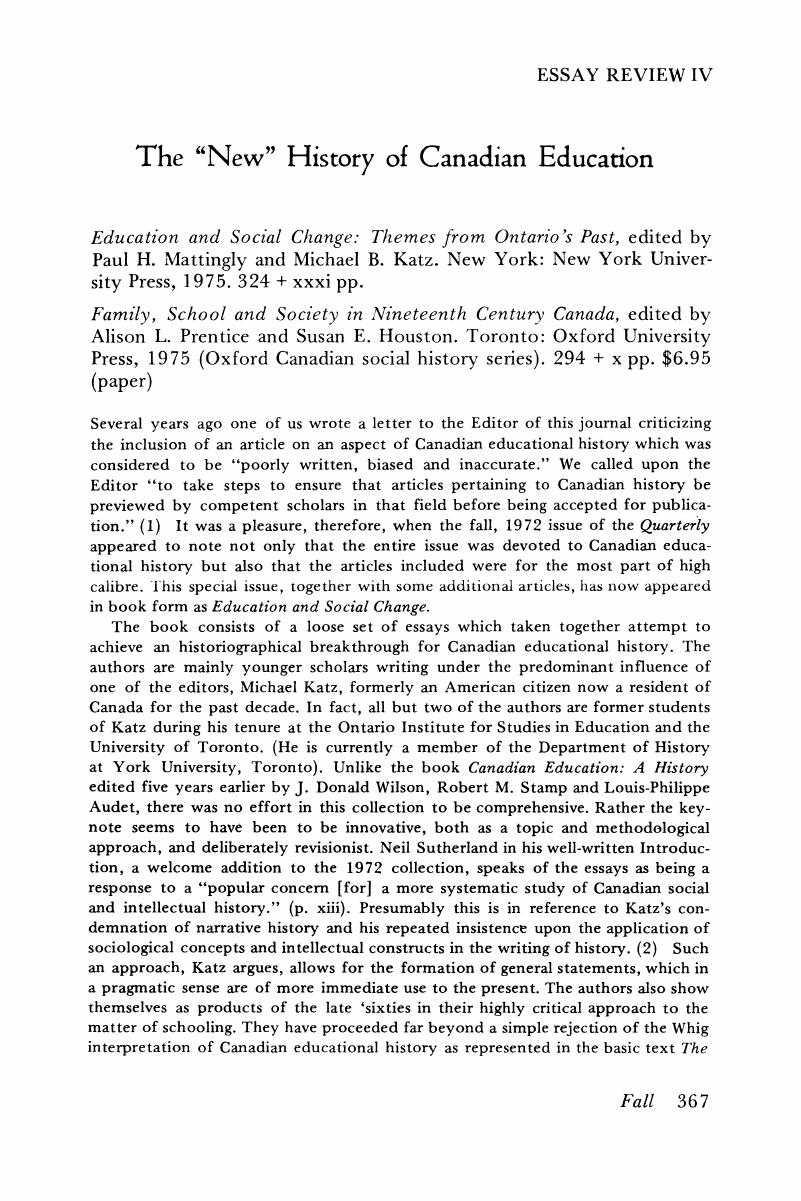Article contents
The “New” History of Canadian Education
Published online by Cambridge University Press: 24 February 2017
Abstract

- Type
- Essay Review IV
- Information
- Copyright
- Copyright © 1976 by New York University
References
Notes
1. Wilson, J. Donald “Canadian Historiography,” History of Education Quarterly, II (Spring, 1969): 88–96.Google Scholar
2. See, for example, Katz, M. B., Class, Bureaucracy and Schools (New York, 1971), p. xxv.Google Scholar
3. Ibid., p. xxvi.Google Scholar
4. Canadian Social History Project, Report No. 5. (Department of History and Philosophy of Education, O.I.S.E., 1973), p. xiv. This report, by the way, errs in stating that the H.E.Q. issue was “devoted entirely to present and former project members.” Neil Sutherland was never a project member.Google Scholar
5. Further evidence of Gidney's being a “moderate” revisionist in Sutherland's categorization can be found in his paper with Lawr, D.A., “The Development of an Administrative System for the Public Schools: The First Stage, 1841–50,” presented at a conference in Toronto on “Egerton Ryerson and His Times” in February, 1976. The papers of the conference are to be published by Macmillan of Canada in the spring of 1977.Google Scholar
6. In a sweeping criticism of Graff's work, two young historians H.J. Mays and H.F. Manzl recently questioned his methodological approach to literacy studies. One of their main points centered on Graff's use of the census as an instrument to determine the extent of literacy in this period. See “Literacy and Social Structure in Nineteenth Century Ontario: An Exercise in Historical Methodology.” Histoire sociale/Social History, 7 (Nov. 1974): 331–45. Graff answered his critics at some length and essentially stood in ground in “What the 1861 Census can tell us about Literacy: A Reply,” Histoire sociale/Social History, 8 (Nov. 1975): 337–49. Despite his spirited defence, however, it is curious to note that Graff saw fit to offer a general disclaimer to being held responsible for his previous work: “It should be made clear that this essay supercedes [sic] all my previous methodological discussions.” Ibid. p. 338, footnote 1.Google Scholar
7. Elsewhere, Katz has contended that the American educational system has remained essentially unchanged since about 1885. Katz, Michael B., Class, Bureaucracy and Schools (rev. ed., New York, 1974).Google Scholar
8. Katz, Michael B. “Class, Bureaucracy and Schools,” in Myers, Douglas (ed.), The Failure of Educational Reform in Canada (Toronto, 1973), p. 25.Google Scholar
9. Katz, , Class Bureaucracy and Schools, p. xx.Google Scholar
- 1
- Cited by




